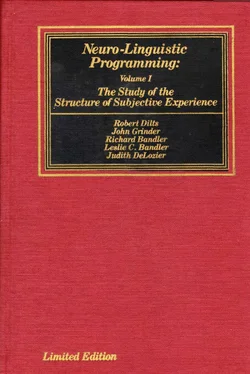If you want to convince them of a particular point, package your communication to match their belief strategies. If you want to influence their decision, utilize their decision making strategies. If you know their strategies well enough, you will know what conclusion they will arrive at, given the available information, so that you can predict and to some degree control what will happen when they are no longer in your presence. You will be able to predict how people of various strategies will interact with one another. And by observing accessing cues and other minimal cues (slight unconscious head shakes or nods, sighs, breathing changes, etc.) you will get feedback for how individual members are responding to your presentation and that of your opposition. You may know that person 1 responded positively to verbalization "X", and will probably be arguing in its favor; person 2 got feeling "Y" from the verbalization and will probably be leaning in a different direction and so on.
It will make your utilization a lot less complicated if you are able to select jury members who all share the same strategy — preferably your own. (Background, sex, political beliefs, and other content differences should be secondary to strategies as selection criteria.) If the opposing attorney shares your strategy, however, it may be better to select a jury of different strategies and rely on your own flexibility in pacing. It may also be to your benefit to hang a jury. In such a case you would want to select jury members of widely varying or opposing strategies. It would be possible to accomplish this by selecting part of the jury to have strategies which pace that of the prosecuting attorney, and the other part to have strategies pacing those of the defense attorney.
Covert anchoring and nonverbal communication can be extremely effective in courtroom situations. Courtrooms are a unique environment for communications because conscious attention is placed overwhelmingly on the digital (verbal) content of the communication (for instance, only the verbal portions of a trial are recorded and later considered). This leaves most of the nonverbal interchanges to take place covertly. Although a great deal of nonverbal intimidation and rapport building occurs in courtrooms, it is generally consciously ignored as significant to the final decision making process. Intimidation or rapport can be strengthened by covertly establishing negative or positive anchors. For example, one of the authors once accompanied a friend to a hearing (a jury was not involved) to observe the proceedings. During a few relaxed moments before the official proceedings had begun, the judge knocked over some objects on his desk accidentally. The court recorder made a witty remark about the judge's "heavy handedness" which immediately set the judge back at ease and even induced genuine laughter from him. The author seized the opportunity to establish a covert anchor for the positive experience by clearing his throat in a unique but innocuous manner that was loud enough to be within the audible range of the judge. A number of other cases were called before that of the author's friend, which gave the author time to reinforce the positive anchor by reproducing the unique clearing of the throat anytime the judge exhibited a noticeable positive response during the proceedings. When the author's friend's case was called the author cleared his throat a number of times as his friend was being initially questioned and inspected by the judge, and frequently during the court proceedings (although not so frequently as to seem out of the ordinary). A quick rapport was established between the judge and the author's friend which lasted throughout the proceedings, which were eventually settled in favor of the author's friend.
Simple tactics like this could be (and are) used just as easily, and more effectively, by the attorneys participating in trials.
Most capable attorneys, of course, will do the majority of their work by settlement out of court, which is generally much more efficient and economical than going to trial. The same rapport building, information gathering and influence tactics may be applied in out–of–court negotiations as well (other techniques, procedures and skills for negotiation will be presented in later portions of this book). If you can elicit the motivation, convincer, decision making, and buying strategies of your client, your opponent and your opponent's attorney, you can utilize each of their strategies to bring about the most rapid and satisfying solution to the negotiation. For instance, if you could elicit the buying and decision making strategy of your opponent's attorney, you could influence him to accept a plea bargaining or a settlement as being more efficient than going to court.
Analogue marking and covert anchoring will be extremely useful tools in such processes.
4.45 Implications for Psychotherapy
We have already described in this chapter a number of ways in which strategies and anchoring could be applied therapeutically. The essential basis of therapy and change is the three–point process—(1) eliciting and applying personal resources to a (2) present or problematic state to assist the client in (3) achieving a desired state. In the transcript on anchoring presented in this chapter we showed how this could be done by integrating, (through collapsing anchors), the client's stored representations of his or her problem state and some relevant resources. Resources consist of reference structures for success from the client's personal history or new 4–tuples created internally by the client.
Problems and resources are defined and identified in relation to the client's abilities to access representational systems and gather, process and respond to information gathered through the sensory channels. The more access a client has to the information provided by all of his representational systems, the more resources he will have. This kind of flexibility will contribute greatly to the adaptability of the individual. The individual's ability to gather and discriminate information about his environment and access the appropriate strategy with which to respond in that environment will be his other major resource. This involves the sequencing of one's behavior in the form of strategies.
Problems occur when an individual gets caught up in one representational system or a strategy that loops, and when he is kept from observing and responding to important cues in the environment. Problems also occur when an individual accesses a strategy or response that is inappropriate for the context.
The therapeutic procedures of neurolinguistic programming are outcome oriented — that is, the client's behavior is engineered to achieve specific outcomes. The essential therapeutic procedure presented thus far in this book is the elicitation and utilization of an appropriate resource strategy of the client's through anchoring and pacing. The programmer, as therapist, would require the same skills for achieving therapeutic outcomes as he would for getting outcomes in any of the other fields discussed so far. Specifically the programmer should be practiced and capable in each of the following:
1. Building Rapport — You will have established rapport with your client when you have elicited in him the kind of behavior that is generally labeled "trust," "responsiveness," etc. Rapport, as we have pointed out, is essential to the success of any communication, interaction or relationship. You will know when you have achieved rapport when you can smoothly and easily lead the client into new experiences. The programmer builds rapport by being sensitive to and by pacing the client's strategies and macro– and micro–behavior such as vocabulary, tonality, tempo, posture, breathing rates, facial expressions and so on. Quickly establishing anchors for resources and positive experiences will contribute to the building of rapport. Therapeutically, rapport serves to help eliminate resistance and speed up the process of change.
Читать дальше











